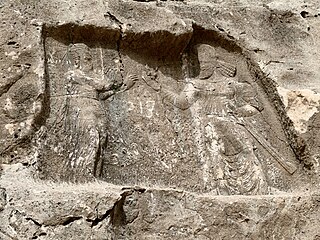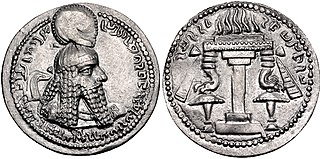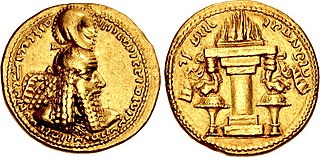 W
WThe Sasanian Empire or Sassanid Empire, officially known as the Empire of Iranians, and called the Neo-Persian Empire by historians, was the last Persian imperial dynasty before the arrival of Islam in the mid seventh century AD. Named after the House of Sasan, it endured for over four centuries, from 224 to 651 AD, making it the longest-lived Persian dynasty. The Sasanian Empire succeeded the Parthian Empire, and reestablished the Iranians as a superpower in late antiquity, alongside its neighbouring arch-rival, the Roman-Byzantine Empire.
 W
WBarm-e Delak, is a site of a Sasanian rock relief located about 10 km southeast of Shiraz, in the Pars Province of Iran. The rock relief was known as Bahram-e Dundalk in Middle Persian, which means Bahram's heart.
 W
WThe Chronicle of Arbela claims to record the early history of Christianity in the city which is now known as Erbil, Iraqi Kurdistan, but which was then Arbela, capital of Adiabene. First published in 1907, its age and historicity are disputed among scholars.
 W
WDerafsh Kaviani, or Derafsh Kavani, was the legendary royal standard (vexilloid) of Iran (Persia) used since ancient times until the fall of the Sasanian Empire. Following the defeat of the Sassanids at the Arab conquest of Persia, the Sassanid standard was recovered by one Zerar bin Kattab, who received 30,000 dinars for it. After the jewels were removed, Rashidun Caliph Umar is said to have burned the standard. The banner was also sometimes called the "Standard of Jamshid", the "Standard of Fereydun" and the "Royal Standard".
 W
WThe exilarch was the leader of the Jewish community in Mesopotamia (Iraq) during the era of the Parthians, Sassanids and Abbasids up until the Mongol invasion of Baghdad in 1258, with intermittent gaps due to political developments. The exilarch was the equivalent of the Katholikos of the Christian Church of the East (Nestorian), and was thus responsible for community-specific organizational tasks such as running courts, collecting taxes, supervising and providing financing for the Talmudic Academies in Babylonia, and the redistribution and financial assistance to needy members of the community. The position was hereditary in a family that traced its descent from the royal Davidic line.
 W
WThe fall of Hatra, capital of the Kingdom of Hatra under Sanatruq II, took place in the 3rd century after a lengthy siege by the Sasanian king Shapur I. Hatra was plundered and abandoned, and its kingdom dissolved.
 W
WGird-î Qalrakh is a tell, or archaeological settlement mound, in the Shahrizor Plain in Iraqi Kurdistan, Iraq. The archaeological site covers an area of 3 hectares according to the excavators; a geomagnetic survey indicated a size of 15 ha. At 26m high, Gird-î Qalrakh has been described as one of the highest mounds in the Shahrizor Plain. Excavations have been carried out in 2016, 2017 and 2019 by a team from the Goethe University Frankfurt. This research showed that the site has been almost continuously occupied from the third millennium BC into the Islamic period. Important discoveries include a substantial stone-built wall from the Neo-Assyrian period, and a well-preserved loom from the Sassanian period. Together with the numerous seals that have been discovered, this suggests that textile production may have been important at Gird-î Qalrakh during this period.
 W
WThe history of Persian Egypt is divided into three eras:Achaemenid Egypt, referring to two periods of Achaemenid rule punctuated by an interval of independence: Twenty-seventh Dynasty of Egypt, also known as the First Egyptian Satrapy. Thirty-first Dynasty of Egypt, also known as the Second Egyptian Satrapy. Sasanian Egypt, referring to a period of occupation by the Sasanian Empire, after the Sasanian conquest of Egypt and shortly before the Muslim invasions
 W
WKhosrow parviz hunting ground or Tape-ye-moradhasel is and ancient Sasanid complex in north of kermanshah city in west of Iran.
 W
WThe Korymbos was a jewel-studded globe containing the top hair of the ruler of the Sasanian dynasty of Iran, resting on his crown. It was introduced by Ardashir I. The art historian Matthew P. Canepa notes that although the Greek word Korymbos or Latin Corymbus has become a scholarly convention to refer to the spherical shape on the top of Sasanian crowns, it is not an indigenous Iranian term.
 W
WKushano-Sasanian Kingdom is a historiographic term used by modern scholars to refer to a branch of the Sasanian Persians who established their rule in Bactria and in northwestern Indian subcontinent during the 3rd and 4th centuries at the expense of the declining Kushans. They captured the provinces of Sogdiana, Bactria and Gandhara from the Kushans in 225 AD. The Sasanians established governors for the Sasanian Empire, who minted their own coinage and took the title of Kushanshas, i.e. "Kings of the Kushans". They are sometimes considered as forming a "sub-kingdom" inside the Sasanian Empire. This administration continued until 360-370 AD, when the Kushano-Sasanians lost much of its domains to the invading Kidarite Huns, whilst the rest was incorporated into the imperial Sasanian Empire. Later, the Kidarites were in turn displaced by the Hephthalites. The Sasanians were able to re-establish some authority after they destroyed the Hephthalites with the help of the Turks in 565, but their rule collapsed under Arab attacks in the mid 7th century.
 W
WThe Plague of Justinian or Justinianic Plague was the beginning of the first plague pandemic, the first Old World pandemic of plague, the contagious disease caused by the bacterium Yersinia pestis. The disease afflicted the entire Mediterranean Basin, Europe, and the Near East, severely affecting the Sasanian Empire and the Roman Empire and especially its capital, Constantinople. The plague is named for the Roman emperor in Constantinople, Justinian I who, according to his court historian Procopius, contracted the disease and recovered in 542, at the height of the epidemic which killed about a fifth of the population in the imperial capital. The contagion arrived in Roman Egypt in 541, spread around the Mediterranean Sea until 544, and persisted in Northern Europe and the Arabian Peninsula, until 549.
 W
WSasanian coinage was produced within the domains of the Iranian Sasanian Empire (224–651). Together with the Roman Empire, the Sasanian Empire was the most important money-issuing polity in Late Antiquity. Sasanian coinage had a significant influence on coinage of other polities. Sasanian coins are a pivotal primary source for the study of the Sasanian period, and of major importance in history and art history in general. The Sylloge nummorum Sasanidarum is the most important primary work of reference for Sasanian coins.
 W
WThe Sasanian coinage of Sindh refers to a series of Sasanian-style issues, minted from 325 to 480 CE minted in Sindh, in the southern part of modern Pakistan, with the coin type of successive Sasanian Empire rulers, from Shapur II to Peroz I. Together with the coinage of the Kushano-Sasanians, these coins are often described as "Indo-Sasanian". They form an important part of Sasanian coinage.
 W
WThe Sasanian crowns refers to the crowns used by the monarchs of the Sasanian dynasty of Iran. Each monarch had their own unique crown, and some of them had several.
 W
WSasanian dress, represented by the Persians, was "broadly similar" to dresses worn by other Iranian peoples. It was especially appropriate and applicable for horse riding. Most extant primary sources for the study of Sasanian dress are forms of visual art, rock reliefs in particular. In relation to the Sasanian dress, Matthew Canepa (2018) states:It consisted of loose-fitting trousers, boots, and a knee-length tunic that was bound with a belt (kamar). A heavy caftan, crossed at the chest, could be worn belted. In 3rd- and 4th-century representations, the tunic appears squared off at the bottom. From the late 4th century, the lower hem is rounded. Ornamental and figural textile motifs become prominent around the 6th and 7th centuries, as is apparent at Taq-e Bostan. Early reliefs and seals portray members of the aristocracy wearing domed or pointed hats (kulāf) with their heraldic symbols (nīšān) on the side, often bound with diadems. Nobles were given the right to wear silk and jewellery. Women’s dress consisted of long, flowing, sleeved or sleeveless tunics. They were worn belted under the breasts with a long cloak worn over the left shoulder or used as a veil. Clothing was an important element in royal gift-giving. It also marked social rank, as did jewellery, and textiles and their motifs. The king bestowed clothing and jewellery as a mark of distinction on those he desired to honour and presented his own robes to especially favoured family and courtiers.
 W
WThe Iranian society in the Sasanian era was an Agrarian society and due to this fact, the Sasanian economy relied on farming and agriculture.
 W
WThe Sassanid Empire or Sassanian Dynasty is the name used for the Persian dynasty which lasted from 224 to 651 AD.
 W
WIn the Sassanid Empire, the state religion Zoroastrianism created the policy that dictated relationships between men and women. Zoroastrianism set what roles women would have, the marriage practices, women's privileges in Sasanian society and influenced Islam when it arose. The moral standards, the structure of life, and the practices of the Sasanian society were found by looking at the religious writing and laws of the time. Women had legal rights, such as to real estate, but the privileges a woman had depended on what type of wife she was, as did the restriction that were placed on her.